The survey results of the inaugural Directors Sentiment Index have been around for several months but recent breakfasts discussing the findings have generated renewed media interest.
The survey provides a useful profile of how directors see their role and lists forecasts of trends but in none of the recent media reports does workplace health and safety receive attention although it is mentioned in the survey results.
The survey, conducted for the Australian Institute of Company Directors (AICD), lists occupational health and safety (OHS) as one of the components of what is described as Environmental, Social and Governance (ESG) issues (page 64).
 (Curiously “Work Health & Safety” continues to be abbreviated to OH&S showing the persistence of OHS).
(Curiously “Work Health & Safety” continues to be abbreviated to OH&S showing the persistence of OHS).
The chart shows that 54% of respondents believe that the importance of OHS issues will increase a little. This can be interpreted in many ways – directors do not know what they are talking about, the OHS profession has a bloated sense of its own importance, a survey over time may provide a better reflection of perception or that the work of Safe Work Australia on OHS and corporate governance is not gaining traction on the agendas at board meetings. Continue reading “Directors Sentiment Index mentions OHS but……”




![cover indg275[1] cover indg275[1]](http://safetyatworkblog.files.wordpress.com/2009/05/cover-indg27511.jpg?w=212)